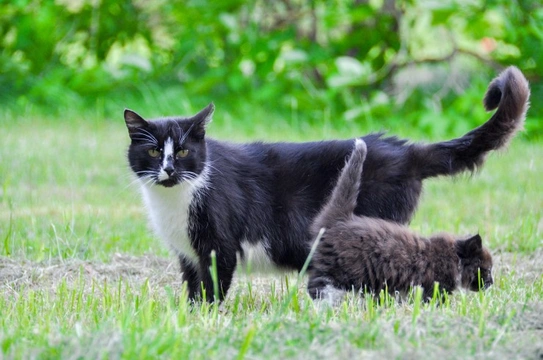
Tail injuries in cats
If you spot a problem with your cat’s tail, such as if it appears to be painful, not supported by the muscle, or has a new visible kink in it, your cat may have injured or even broken their tail. Tail injuries in cats can be caused by many different things, and can range from serious and very painful, potentially affecting the spine, bowel and bladder as well, to the minor and not particularly problematic that may ultimately heal by itself.
The cat’s tail is an extension of their spine, and along much of the length of it, contains bone and vertebrae that are nerve-rich and an important part of the anatomy. If you spot a problem with your cat’s tail or suspect that they might have broken their tail, you should seek veterinary advice sooner rather than later.
What causes tail injuries in cats?
Various different types of external traumas can lead to tail injuries or breaks, although fortunately, most cats will go through their entire lives without suffering from any of them. Some of the most common causes of tail injuries include:
- Getting their tail trapped in a door
- Being inadvertently stepped on
- Bites from other animals
- A hard pull to the tail
- Road traffic accidents
- Anything else that causes an impact or trauma to the lower spine or the tail itself
Signs that your cat has injured their tail
Tail injuries are generally fairly noticeable, and you will usually be able to physically spot that something is amiss. Be on the lookout for any o the following symptoms either alone or in combination:
- A noticeable kink or break in the tail
- The tail being extremely painful to touch
- Signs of a bite or injury that has broken the skin, or any infection
- The tail feeling hot and inflamed
- Part of the tail being swollen
- The tail hanging down and not able to support itself
- Paralysis or numbness of the tail
- Issues with the back legs, balance or walking
- Faecal or urinary incontinence, or not being able to go to the toilet at all
Diagnosing tail injuries
When you take your cat to the vet, again it will usually be fairly apparent to them if the tail has been injured or broken. This is particularly true if you know how the injury or incident occurred, for instance if you accidentally stood on your cat or witnessed them becoming injured.
However, your vet will also have to determine exactly what part of the tail is affected, how much of the tail is affected, and if the trauma continues from the base of the tail into the spine. In order to do this they may need to x-ray your cat, and perform a physical examination and manipulation of the tail to identify the extent of the damage.
If the tail is paralysed or the condition is also affecting the back legs and bowel and/or bladder control, your vet may need to perform blood tests and urinalysis as well as possibly an ultrasound scan and various other tests. This is necessary in order to find out how bad the injury is, or if the symptoms are in fact being caused by an underlying health condition rather than a trauma.
Treating tail injuries in cats
How treatment is undertaken will depend on the extent of the damage and how greatly it is affecting the cat.
If the tail is paralysed but the spine and movement are unaffected and the vet does not think it likely that feeling will return to the tail, the tail will usually be amputated. While cats use their tails to help with balance and navigation, with a little adjustment, cats can learn to manage without their tails with no problem in most cases.
If there is a break towards the end of the tail that is not affecting movement or interfering with the operation of the bowel and bladder, the tail will often heal on its own with time, particularly if the injury is at the very tip, past the last of the vertebrae.
However, if the break is lower down, your vet may decide to surgically repair the break or fracture, or amputate the tail from the affected point.
While any tail break or trauma injury will generally be very painful for your cat, the most serious problems with the tail can also affect the spine and the back legs, and your cat’s control of their bowel and bladder. If this is the case, your vet will need to consider whether or not correcting the problem will restore free movement and feeling, or if the damage caused cannot be rectified.
The cat may need to remain in the practice as an inpatient for several days or even longer in order to allow time for healing and the assessment of whether or not the damage can be rectified.
If the cat is unable to go to the toilet, the vet will also need to manually express the cat’s bowel and bladder during this time. The ultimate question is whether or not the injury will heal with either time or treatment; if paralysis of the limbs is irreversible or if the cat will never be able to go to the toilet on their own, usually the decision to put the cat to sleep is the only viable and kind option.



